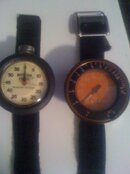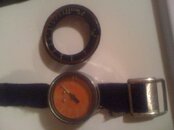You are using an out of date browser. It may not display this or other websites correctly.
You should upgrade or use an alternative browser.
You should upgrade or use an alternative browser.
depth gauge
- Thread starter WeldonDowd
- Start date
Please register or login
Welcome to ScubaBoard, the world's largest scuba diving community. Registration is not required to read the forums, but we encourage you to join. Joining has its benefits and enables you to participate in the discussions.
Benefits of registering include
- Ability to post and comment on topics and discussions.
- A Free photo gallery to share your dive photos with the world.
- You can make this box go away
WeldonDowd
Contributor
I acquired some other pretty cool stuff too that I'll slowly ask questions about if I have any.
- Messages
- 22,171
- Reaction score
- 2,803
- # of dives
- 5000 - ∞
Bottom timer's nice ... does it work?
The capillary gauge served two functions, it let you check the oil filled gauge on the way down and it gave you greater accuracy for your deco stops on the way up.
The capillary gauge served two functions, it let you check the oil filled gauge on the way down and it gave you greater accuracy for your deco stops on the way up.
WeldonDowd
Contributor
Gotcha, thanks. The bottom timer works. I figure it starts ticking at a certain depth because when you push on the rubber pressure sensor on the back it counts time; it is accurate.
Those USD depth gauges were notorious for being inaccurate. We were issued them in the U.S. Air Force Pararescue, and I remember a dive we made looking for a helicopter that had crashed at sea off one of the Ryukyu Islands near Okinawa in 1968 or so. The eye witness put the helicopter just off a reef, and four of us made an entry. We wanted to descend to the bottom and do a circle search, but as we swam down, no bottom appeared. We had been going down for quite a while, and our dive leader gathered us together to check our depth gauges. These were all this USD type, with the orange dial (I still have one). Well, they read anywhere from about 30 feet to almost two-hundred feet, and we could not see the bottom in great visibility. So we aborted the dive. On that gauge, the capillary gauge is probably more accurate than the other mechanism (bourdon tube or diaphragm, I cannot determine which) when it was new and still had all the oil in it.
SeaRat
SeaRat
I love that stuff with character
When I rebuild those characterful things I raid the
mental hospital medical refuse receptacles for IV tubing
IV tubing, not four tubing, but not every time
because one raid leaves enough for plenty
Not that I'd go diving headfirst into the refuse receptacle
no matter how excited I got.
Definately not for surf n sun n fun n sand entries if it's the
one where a floating face acts on the oil to operate the mechanism
When I rebuild those characterful things I raid the
mental hospital medical refuse receptacles for IV tubing
IV tubing, not four tubing, but not every time
because one raid leaves enough for plenty
Not that I'd go diving headfirst into the refuse receptacle
no matter how excited I got.
Definately not for surf n sun n fun n sand entries if it's the
one where a floating face acts on the oil to operate the mechanism
WeldonDowd
Contributor
Thanks for raining on my parade Ratcliff. I thought I had something usable. 
Weldon,
You may have something usable. Just test it first.
SeaRat
You may have something usable. Just test it first.
SeaRat
WeldonDowd
Contributor
Thanks man, I was just picking a bit. Thanks for that information though because a google search for that gauge comes up empty. Moreover, you have one heck of a memory.
- Messages
- 5,141
- Reaction score
- 4,150
- # of dives
- 5000 - ∞
Weldon,
I believe you have a Bourdan/Capillary gauge
Prior to a test dive I would suggest that you perform some preventative maintenance.
A)Purchase a bottle of clear cyder vinegar
B)Capillary
***1) disassemble the unit to it's 3 component parts, the plug, the entrance plug and the tube
C)Bourdan
***1) Check for obstructions in the opening on the side
***2) Clean with opening with a wire brush
E)Soak all components of both gauges in the vinegar..over night to a week or more
F)Wash with fresh water
G)Purchase a package of pipe stem cleaners
H)Ream the Capillary tube with the pipe cleaners
until clean and clear
I)Reassemble Capillary
J)Test Dive
***1) both units should read about the same
Repeat the above periodically depending on dive frequency.
If the bourdan tube unit reads different it is stopped up and possibly sprung and useless as a dive instrument, place on shelf or toss.
Re Bottom Timer
They were made many years ago and are probably considered antique or vintage.
Bottom Timers do not begin registering until about 7 feet of water. To test just gently press on the case it should react with a arrow movement
Hope this is in some way helpful,
SDM
I believe you have a Bourdan/Capillary gauge
Prior to a test dive I would suggest that you perform some preventative maintenance.
A)Purchase a bottle of clear cyder vinegar
B)Capillary
***1) disassemble the unit to it's 3 component parts, the plug, the entrance plug and the tube
C)Bourdan
***1) Check for obstructions in the opening on the side
***2) Clean with opening with a wire brush
E)Soak all components of both gauges in the vinegar..over night to a week or more
F)Wash with fresh water
G)Purchase a package of pipe stem cleaners
H)Ream the Capillary tube with the pipe cleaners
until clean and clear
I)Reassemble Capillary
J)Test Dive
***1) both units should read about the same
Repeat the above periodically depending on dive frequency.
If the bourdan tube unit reads different it is stopped up and possibly sprung and useless as a dive instrument, place on shelf or toss.
Re Bottom Timer
They were made many years ago and are probably considered antique or vintage.
Bottom Timers do not begin registering until about 7 feet of water. To test just gently press on the case it should react with a arrow movement
Hope this is in some way helpful,
SDM
Similar threads
- Replies
- 2
- Views
- 511
- Replies
- 0
- Views
- 303
- Replies
- 0
- Views
- 381
- Replies
- 1
- Views
- 308
- Replies
- 47
- Views
- 4,243





